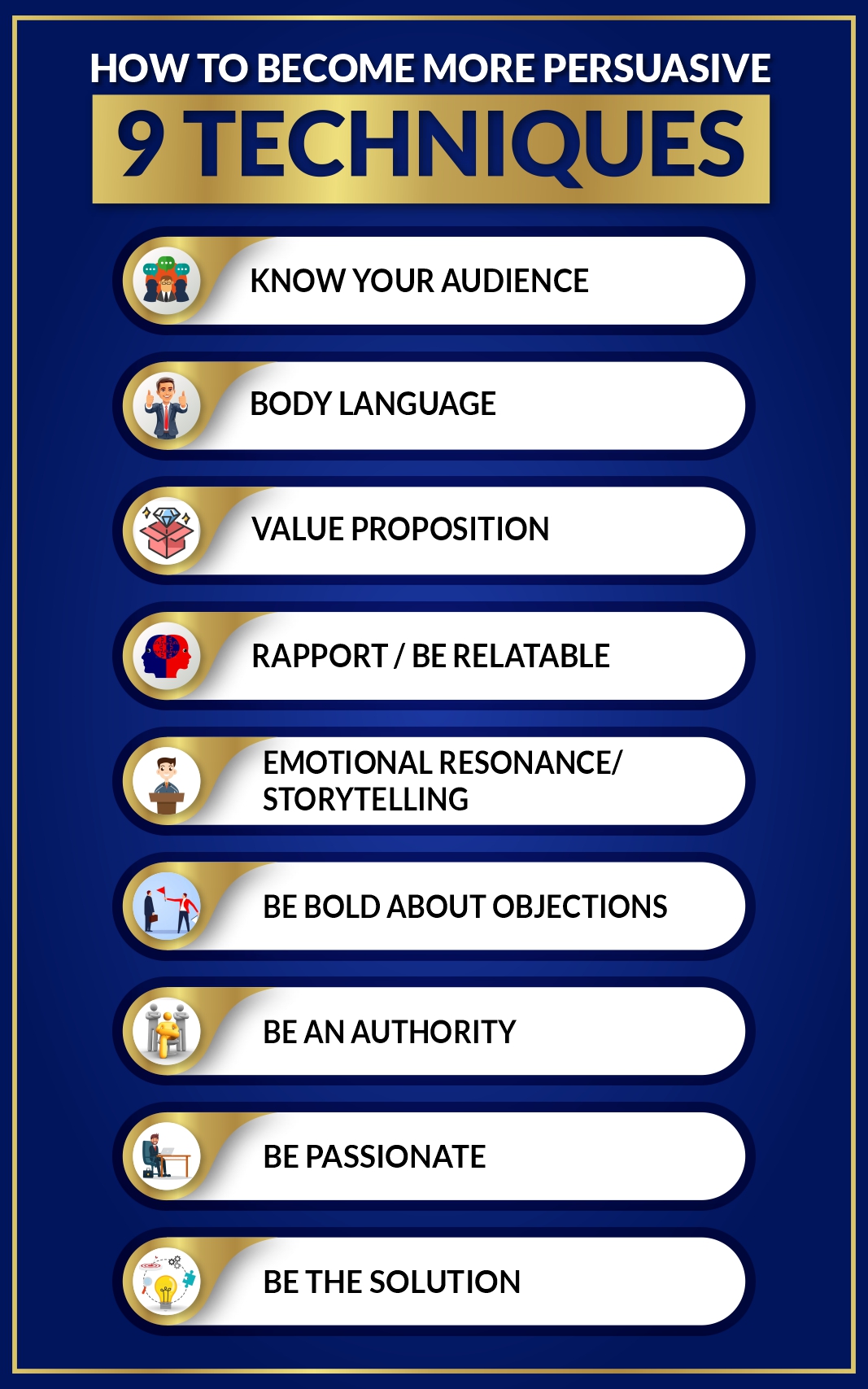Persuasion is an art and a skill that, when effectively executed well, is a potent proponent in achieving business goals. According to Very Well Mind, persuasion is a symbolic process in which communicators try to convince other people to change their attitudes or behaviors regarding an issue through the transmission of a message in an atmosphere of free choice.
Although everyone innately possesses some level of persuasive skill, we can all become more persuasive. Many will ask in wonderment, “How does one become more persuasive?” Firstly, by following this simple communication hack by Ron Malhotra, “Delete all the words not required.” Persuasion may require convincing words, but it’s still important to be concise and strategic.
The next step is to implement persuasive techniques. By utilizing persuasive techniques such as establishing trust and credibility, comprehending the reader’s purpose to align with your own, paying attention to language, and using tenets such as rhetoric and repetition, you are well on your way to being persuasive. These principles are all rooted in the fundamental techniques of effective persuasion – ethos (speaker’s status or authority), pathos (emotional appeal), and logos (audience reasoning ability).

1. Know Your Audience
It doesn’t matter what you have to say if you don’t know the people you are saying it to. Whether it’s a large crowd, a single person, or a panel of colleagues, equipping yourself with knowledge of who you are speaking to goes a long way in making your persuasion more effective.
If you’re addressing a crowd, then it is vital to know the demographic of your audience so you can craft your persuasion to appeal to them. If you’re using your persuasive techniques for a prospective client, your boss, or as a leader, you must know their dominant personality traits, strengths, and weaknesses. By knowing these factors, you can strategically play upon them, ultimately leveraging them to your benefit. This simple technique will aid you immensely when persuading in business.
2. Body Language
Even before you begin to speak, your body language is shouting from the rooftop. Perhaps the most underrated aspect of persuasive communication techniques is body language. A great way to be convincing is ensuring your body language is just as persuasive as your words.
A confident stance is one of the first steps in persuasion. Presenting yourself as self-assured to your audience creates a great first expression. Our body language sets the tone for the discourse that is to follow.
Open your posture, stand tall and make eye contact. Resist the urge to fidget or constantly dart your eyes. Actions of this nature make others feel uneasy and make you appear as lacking trust and credibility. Use your hands to gesture (but not too much) and loosen your facial expression to flow with the conversation.
3. Value Proposition
One of the initial setbacks to fully maximizing persuasive communication is the fear of manipulating people. A practical, compelling tool of leaders is persuasive communication without compromising integrity. The solution to this is the value proposition.
Science of People states that a value proposition, or positioning statement, is basically a 30-second elevator pitch of what you do and why your product or service is valuable. When you have the undivided attention of a decision-maker or someone you are trying to convince, your value proposition answers your audience’s questions. These questions include:
What does your service/product/expertise mean for me?
Why should I buy this product/service or hire you over all others we’re considering?
How is your expertise/product/service different from others we’re looking at?
What problem does your service/product/expertise solve?
Why should I listen to you?
Your value proposition will serve as an effective tool for propelling your persuasion in business communication.
4. Rapport/ Be Relatable
Another great skill to employ for persuasion in business is the ability to build rapport with your audience rapidly. You do this by ensuring that you are personal. You start off with the universal language of a smile and you follow up by making your audience feel like they just happen to be having a kitchen table talk with an expert. Ensure you speak to your audience values by speaking with them and not to them, or worse above them. Persuasion is only possible if people are comfortable enough to be open to what you’re saying.
5. Emotional Resonance/Storytelling
A highly effective persuasive tip to increasing your relatability and garner a potent emotional response is telling a personal story.
When an audience hears a personal story, they latch on emotionally. When they can picture themselves in your situation, they begin to understand you better and greater levels of trust can be built. When you manage to persuade someone from an emotional stance, half of the work of convincing them is complete. Whether you’re selling a product or service, it is always wise to ensure you find an emotionally relatable ground. Don’t ever underestimate the power of leveraging personal storytelling.
6. Be Bold About Objections
One of the most effective persuasive techniques is acknowledging objections to what you’re saying. If you’re a speaker, this could be opposing studies or dogmas. If you’re a seller, then your objection can take the form of product and service competitors. It doesn’t matter the capacity as long as you identify, compare, and contrast the objections.
By doing this, you present yourself as fair and unbiased. It allows you to speak about something familiar to your audience and shows how your offerings are better. Recognizing opposing forces shows you aren’t stuck in your bubble and that you appreciate other words, people, and products that aren’t your own. Giving credence to objections shows that you are confident in what you feel, so highlighting the competition only makes you look even better. Stuck asking yourself how to be more persuasive objectively? Then this is one of the best persuasive tips you will ever encounter. Always remember, “Massive success, requires massive courage” (Ron Malhotra)
7. Be An Authority
A persuasive conversation is only possible if you are an authority on the topic of discussion. You can only persuade someone if they believe that you are coming from a place of knowledge. You must be the best in your arena and with evidence to boot if you wish to persuade anyone.
Presenting yourself as a thought leader or an expert with accolades ensures your audience won’t think twice about what you’re telling them. If no one thinks you’re of the ilk to be dispensing the information, they simply won’t believe.
Also Read: Dos and Don’ts of Public Speaking with Pro Tip
There is no such thing as too much credibility when persuading your audience. But be sure to do this without coming across as arrogant.
8. Be Passionate
Being passionate is just as crucial as being an expert. People love accolades as much as they love someone who is impassioned about their products or services. Don’t hold back on the love you have for what you’re doing. Bubbling over with passion also goes a long way in helping to invoke a strong emotional response in your audience. There is nothing more gripping or convincing than someone who has a genuine love for what they do.
People can quickly pick up on inauthenticity and lack of interest. No one wants to buy something that the seller does not appear to be genuinely interested in. If you truly believe that your product and service is worthwhile, people will more quickly be persuaded by you.
9. Be The Solution
Another critical component of persuasion is being the solution. The surefire way to achieve persuasion in business is solving a problem that almost seems insurmountable.
When you couple your authoritativeness with confidence, critiques, and a solution, you won’t have much left to do in convincing anyone that you’re the best choice. Be bold with your assertions. Don’t be afraid to say you are the best. The easiest way to persuade someone is to be clear and concise in who you are, what you do, and how well you do it.
So be bold. Don’t say, “I think” or “I believe.” Instead, confidently quip, “I know.” Stop adding qualifiers to your speech. If you think something will work, say it will work. If you believe something will work, give reasons why it will work. The minute you second guess yourself, everyone else will realize it, and you lose your advantage and the opportunity the persuasive conversations hold.
When presenting yourself, ideas, or products as the solution, you must eliminate the idea of any potential risks. By eliminating any perceived risks, you encourage people to accept your idea or try your products safely. Methods such as authentic positive testimonials, money-back guarantees, and being open to providing additional information or education surrounding the concept can help eliminate the potential loss-aversion that could prevent someone from fully engaging with your ideas or products.
Final Thoughts
A persuading conversation is not merely words but a mixture of engaging dialect, assertive body language, and solutions. It doesn’t matter the audience, the industry, or product; persuasive communication in business is the key to consistent success.
Pick your words carefully, be straightforward, ooze confidence, wave your accomplishments and be prepared to persuade like the professional you are.
It won’t be easy; persuasion is a time-honored skill that needs to be perfected. But guess what, nothing in life worth having is easy. Ron Malhotra said it best when he posited, “Life is hard, but it’s harder for those who expect it to be easy.”
FAQ
Why is persuasion important?
Persuasion is important as it allows you to directly influence someone’s thoughts and responses to a specific situation or topic. Effective persuasion will see your influence resulting in a scenario favorable to you.
What is persuasion in business?
Persuasion in business is the ability to lead customers, peers, or staff to create your desired outcome. In business, through marketing, you persuade customers to purchase products or services, thus driving up sales and increasing profits. In corporations, being an effective leader is usually characterized by the ability to persuade your team to align with each other and work with specific materials or technologies to maximize productivity.
What is a persuasive repetition technique?
Persuasive repetition is the technique utilized to elicit resonance with your audience. According to psychologists, you eventually convince your audience that what you’re saying is true when you use repetition. The more you say something, the more your listeners will be inclined to believe.
What is heuristic persuasion?
The heuristic model of persuasion is a theory detailing that persuasive messages can be digested in two different ways – systematic and heuristic. Systematic processing is the careful assessment of the merits of relevant information in the persuasive content. The Heuristic method of processing is the use of a subset of the information in the content as a foundation for determining if the message should be accepted.
What are persuasive techniques in advertising?
Ethos, pathos, and logos are the three categories of persuasive advertising techniques. Each type describes a different appeal between speaker and audience. Ethos calls upon the speaker’s ethics, or the values. Pathos speaks to the emotional resonance of the speaker to the audience, and logos appeals to the audience’s logical reasoning ability.




Recent Comments